英语医学论文格式要求
- 格式:doc
- 大小:96.50 KB
- 文档页数:10
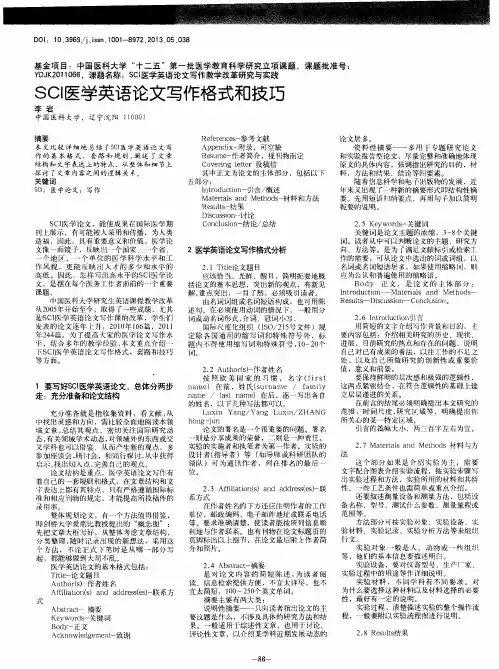
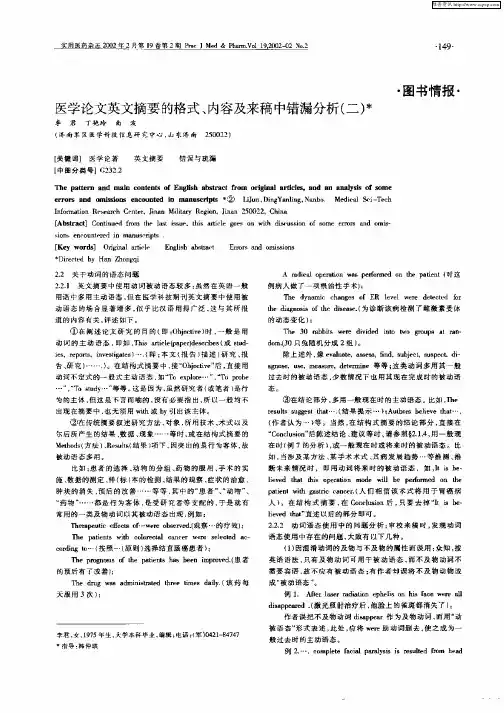


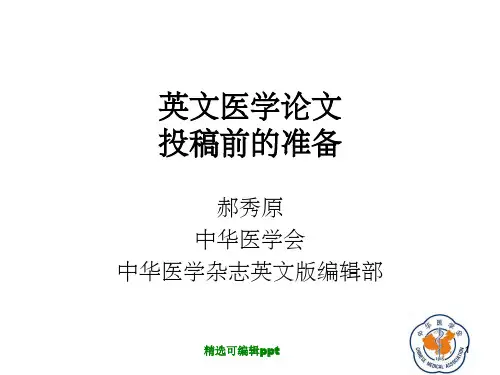
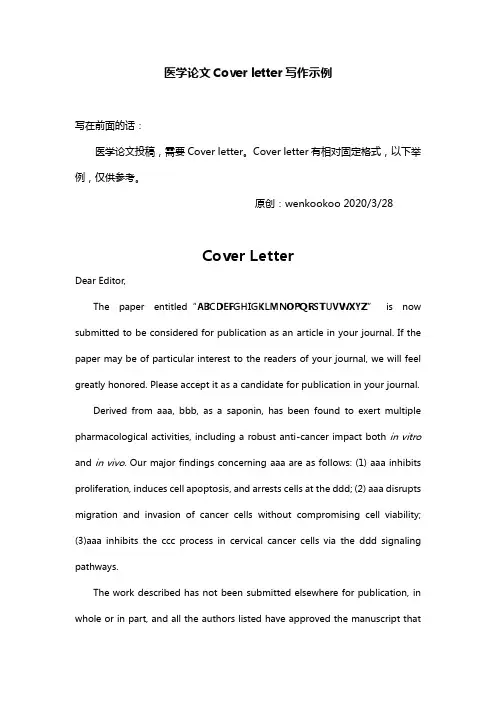
医学论文Cover letter写作示例写在前面的话:医学论文投稿,需要Cover letter。
Cover letter有相对固定格式,以下举例,仅供参考。
原创:wenkookoo 2020/3/28Cover LetterDear Editor,The paper entitled“ABCDEFGHIGKLMNOPQRSTUVWXYZ” is now submitted to be considered for publication as an article in your journal. If the paper may be of particular interest to the readers of your journal, we will feel greatly honored. Please accept it as a candidate for publication in your journal.Derived from aaa, bbb, as a saponin, has been found to exert multiple pharmacological activities, including a robust anti-cancer impact both in vitro and in vivo. Our major findings concerning aaa are as follows: (1) aaa inhibits proliferation, induces cell apoptosis, and arrests cells at the ddd; (2) aaa disrupts migration and invasion of cancer cells without compromising cell viability;(3)aaa inhibits the ccc process in cervical cancer cells via the ddd signaling pathways.The work described has not been submitted elsewhere for publication, in whole or in part, and all the authors listed have approved the manuscript thatis enclosed.We deeply appreciate your consideration of our manuscript, and we look forward to receiving comments from the reviewers. If you have any queries, please don’t hesitate to contact us at the following address aaabbbccc@.Thank you very much for your attention to our paper.Best regards,zzz。


医学期刊英文标题和摘要的书写技巧标签:医学论文;英文摘要;标题;书写技巧随着医学科技的发展和国内外学术交流的日益增多,医学期刊英文标题和摘要的作用显得越发重要。
目前,在国外期刊发表医学论文,根据国际惯例,论文前面需要有英文标题和摘要。
在国内发表的医学论文,除中文摘要外,也要求有英文标题和摘要。
然而,有些投稿的医务工作者不太清楚英文标题和摘要的写作要求,或在英语的表达方存在这样或那样的错误,阻碍了文章的顺利发表。
英文标题和摘要应以简明扼要的形式介绍文章的主要内容,使读者能一目了然该论文是否符合他们进一步继续阅读全文的需要。
同时,国内外一些著名的医学检索机构,也是根据英文标题和摘要决定是否对该文进行收录。
因此,英文标题和摘要是文章发表的关键,是将优秀医学论文介绍给更多读者和促进国际学术交流的重要桥梁[1]。
1 英文标题翻译应注意的几个问题1.1 标题要体现文章的重点标题是读者了解文章内容以决定是否阅读全文的首要信息,是文章内容的高度概括[2 ]。
阅读文章标题的读者要远远多于阅读文章正文的读者[3]。
因此,写好文章英文标题是很重要的。
医学论文的英文标题长短在一般的医学杂志中没有硬性规定,有些杂志,如美国的Journa l of the National Cancer Institute明文规定不得超过14个词;Archives of Intern al Medicine规定标题,包括副标题不得超过两行(每行为42个印刷符号)。
英文标题应避免使用完整句子,一般都采用名词性标题,并且往往省略定冠词[4]。
1.2 英文标题常用词的译法及介词搭配在国内期刊中,标题经常使用“探讨”、“体会”、“总结”、”初步”、“问题”、“报告”、“调查”、“观察”等。
①表示“探讨”的英语翻译及介词搭配:discuss on, an evaluation of, an approach t o, study on/ a study of,investigation of。
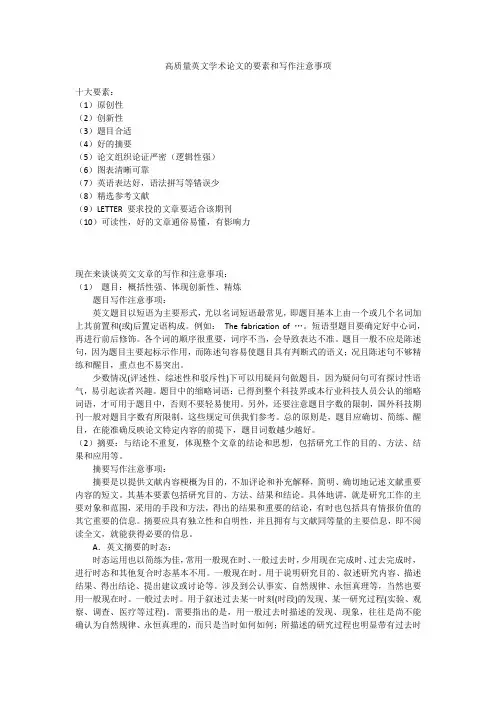
高质量英文学术论文的要素和写作注意事项十大要素:(1)原创性(2)创新性(3)题目合适(4)好的摘要(5)论文组织论证严密(逻辑性强)(6)图表清晰可靠(7)英语表达好,语法拼写等错误少(8)精选参考文献(9)LETTER 要求投的文章要适合该期刊(10)可读性,好的文章通俗易懂,有影响力现在来谈谈英文文章的写作和注意事项:(1)题目:概括性强、体现创新性、精炼题目写作注意事项:英文题目以短语为主要形式,尤以名词短语最常见,即题目基本上由一个或几个名词加上其前置和(或)后置定语构成。
例如:The fabrication of …。
短语型题目要确定好中心词,再进行前后修饰。
各个词的顺序很重要,词序不当,会导致表达不准。
题目一般不应是陈述句,因为题目主要起标示作用,而陈述句容易使题目具有判断式的语义;况且陈述句不够精练和醒目,重点也不易突出。
少数情况(评述性、综述性和驳斥性)下可以用疑问句做题目,因为疑问句可有探讨性语气,易引起读者兴趣。
题目中的缩略词语:已得到整个科技界或本行业科技人员公认的缩略词语,才可用于题目中,否则不要轻易使用。
另外,还要注意题目字数的限制,国外科技期刊一般对题目字数有所限制,这些规定可供我们参考。
总的原则是,题目应确切、简练、醒目,在能准确反映论文特定内容的前提下,题目词数越少越好。
(2)摘要:与结论不重复,体现整个文章的结论和思想,包括研究工作的目的、方法、结果和应用等。
摘要写作注意事项:摘要是以提供文献内容梗概为目的,不加评论和补充解释,简明、确切地记述文献重要内容的短文。
其基本要素包括研究目的、方法、结果和结论。
具体地讲,就是研究工作的主要对象和范围,采用的手段和方法,得出的结果和重要的结论,有时也包括具有情报价值的其它重要的信息。
摘要应具有独立性和自明性,并且拥有与文献同等量的主要信息,即不阅读全文,就能获得必要的信息。
A.英文摘要的时态:时态运用也以简练为佳,常用一般现在时、一般过去时,少用现在完成时、过去完成时,进行时态和其他复合时态基本不用。
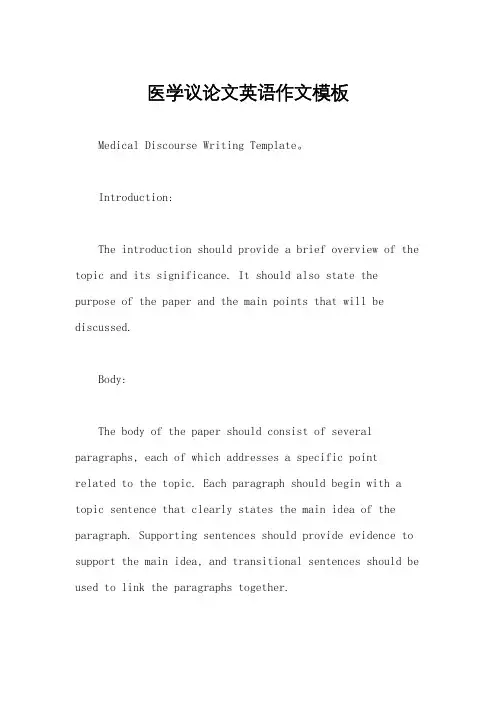
医学议论文英语作文模板Medical Discourse Writing Template。
Introduction:The introduction should provide a brief overview of the topic and its significance. It should also state the purpose of the paper and the main points that will be discussed.Body:The body of the paper should consist of several paragraphs, each of which addresses a specific point related to the topic. Each paragraph should begin with a topic sentence that clearly states the main idea of the paragraph. Supporting sentences should provide evidence to support the main idea, and transitional sentences should be used to link the paragraphs together.Conclusion:The conclusion should summarize the main points of the paper and restate the thesis statement in a new way. It should also provide some final thoughts or recommendations related to the topic.Medical Discourse Writing Sample。
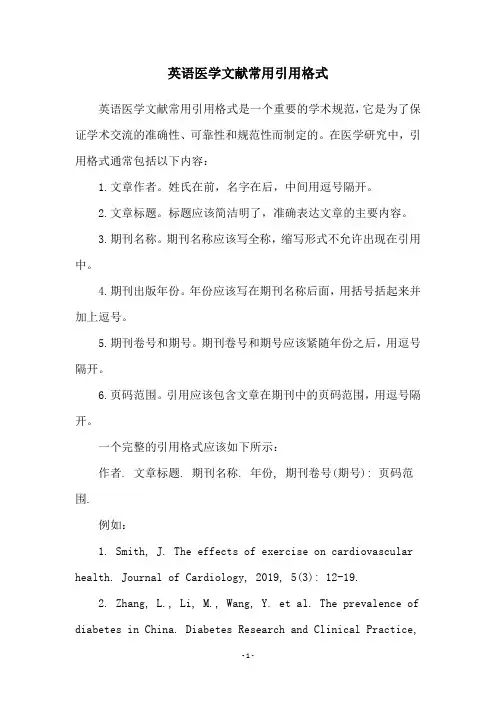
英语医学文献常用引用格式
英语医学文献常用引用格式是一个重要的学术规范,它是为了保证学术交流的准确性、可靠性和规范性而制定的。
在医学研究中,引用格式通常包括以下内容:
1.文章作者。
姓氏在前,名字在后,中间用逗号隔开。
2.文章标题。
标题应该简洁明了,准确表达文章的主要内容。
3.期刊名称。
期刊名称应该写全称,缩写形式不允许出现在引用中。
4.期刊出版年份。
年份应该写在期刊名称后面,用括号括起来并加上逗号。
5.期刊卷号和期号。
期刊卷号和期号应该紧随年份之后,用逗号隔开。
6.页码范围。
引用应该包含文章在期刊中的页码范围,用逗号隔开。
一个完整的引用格式应该如下所示:
作者. 文章标题. 期刊名称. 年份, 期刊卷号(期号): 页码范围.
例如:
1. Smith, J. The effects of exercise on cardiovascular health. Journal of Cardiology, 2019, 5(3): 12-19.
2. Zhang, L., Li, M., Wang, Y. et al. The prevalence of diabetes in China. Diabetes Research and Clinical Practice,
2020, 107(2): 233-239.
总之,准确的引用格式对于医学研究的质量和可信度至关重要。
在撰写科技论文和医学研究的过程中,我们必须熟悉和遵守这些引用规范。
医学英语论文写作—文题关键词:英语论文写作在医学论文的各部分中,文题是篇幅最少的,但它对于整篇论文的意义却不能仅仅以其篇幅多少来衡量[1].比如,文献检索时,我们都会经历这样一个过程:在用关键词检索到众多文献后,首先会根据文题进行第一次筛选。
假如文题不能很好地反映论文的主题,一种可能是被漏选,使作者的研究不能得到充分的传播,并使检索者不能全面地阅读到符合条件的论文;另一种可能是被误选,最终的结果仍是作者的论文不能得到利用,以及使检索者在不符合条件的文献上耗费了许多无效的时间。
因此,毫不夸张地讲,文题的恰当与否是与论文发表后的利用情况息息相关的,也是影响医学信息传播的一个重要环节。
在世界性的《生物医学论文投稿的统一要求》(Uniformrequirementsformanuscriptssubmittedtobiomedicaljournal中,对文题的要求只有短短两条:简练(concise)和反映论文主题(informative)。
其中,笔者认为,“反映论文主题”应当是文题写作的首要原则,在此基础上,尽可能做到“简练”。
1如何使文题恰当地反映论文的主题?使文题恰当地反映论文的主题,目的是让读者通过阅读文题就可以了解到论文所报道的研究概况。
科学研究通常的思路是在一定的条件下,对特定的指标进行检测,根据结果验证预先提出的假设,所以,能够反映论文主题的也就有以下几个指标:研究目的、研究对象、研究方法、实验条件,检测指标、研究结果和结论。
显而易见,在文题中包括所有的内容是不现实的,但是,我们可以某一方面为主,从不同角度反映论文的基本内容。
一种是描述性文题(indicativetitle),即主要向读者介绍论文报道了哪些方面的工作,反映这一内容的指标有研究对象、研究方法、实验条件和检测指标。
另一种是结论性文题(declarativetitle),也就是将研究的结论作为文题。
由于不同的科学研究目的和性质并不完全相同,不是所有的科学研究都可以得出很确实肯定的结论,若这时仍使用结论性文题,则有悖于科学研究报道中的客观标准。
如何发表医学SCI论文写作及技巧英文医学论文(medical papers)的定义医学论文是对整理和发表医学研究成果的一种特殊文本的总称,就其内容和文体特点而言科分为以下几种:1.医学科研论文(scientific papers)2.调查报告(survey)3.综述(review)4.学位论文(theses)5.医学科研论文(scientific papers)医学科研论文定义国际生物学编辑委员会对医学科研论文的定义为:必须是首次公布的应提供足够的资料,使同行们能够进行:①评价所观察到的结果;②评价其推理过程;③重复实验。
分为以下两种:①临床研究(clinical study);②基础研究或实验研究(experimental study)医学科研论文的格式(1)标题(title)(2)摘要(abstract)(3)引言(introduction)(4)材料和方法(materials and methods)(5)结果(results)(6)讨论(discussion)(7)致谢(acknowledgement)(8)参考文献(references)一、标题(一)要求1.简明扼要(short and concise)(1)尽量控制在一行,但不是一个句子(2)不超过25个单词或120-140个字母(3)除DNA、RNA、CT等不用缩写2.信息丰富(informative)3.便于索引(indexing)4.较长标题可采用副标题(二)标题写作中常用词组和表达方式1.用…(方法/手段)对…进行研究/分析/观察/评价:Study(analysis/observation/evaluation/assessment) of (on) …(by) using 方法/with工具)2.A对B的作用Effort of A on BProtective effect of omeprazole on endothelin-induced gastric mucosal injury3.A与B的关系Correlation (relation/relationship) between A and BCorrelation of A with B and C常用修饰词:positively/negatively/significantly/insignificantly4.用…治疗…Use of …in the treatment of …(病)in …(生物)Use of omeprazole in the treatment of gastric ulcer in the elderly5.A是B A as B二、著录部分书写(一)姓名标准式:WANG aobang,HUANG aobang,GUO Xiao’an (二)地址800 Xiang Yin Road, Shanghai 200433, P.R.China(三)资助A project funded by the National “863” Program三、摘要的分类与格式摘要是作者要给读者的精华,分两大类:(一)指示性摘要(二)资料性摘要1.非结构式摘要缺点:段落不明,给编辑、审稿、阅读和计算机处理带来诸多不便2.全结构式摘要(8要素摘要)(1)目的(2)设计(3)地点(4)对象(5)处理(6)主要测定项目(7)结果(8)结论全结构式摘要的优点(1)观点更明确(2)信息量更大(3)差错更少(4)符合计算机数据库建立和使用的要求全结构式摘要的缺点:烦琐、重复、篇幅过长3.半结构式摘要(四要素摘要)(1)目的(objective/purpose/aim)(2)方法(methods)(3)结果(results)(4)结论(conclusion)目的:是作者想要介绍的关键问题一、目的格式(一)单表目的(二)背景+目的二、目的常用时态(一)背景:现在时(一般现在时、完成时和进行时)(二)目的:一般现在时/现在完成时,或一般过去时举例:(1)To evaluate the effects on 24-hour intragastric pH levels of infusions with omeprazole and H2 receptor antagonists in bleeding duodenal ulcer patients.(2)The role of omeprazole in triple therapy and the impact of Helicobacter pylori resistance on treatment outcome are not established. This study investigated the role of omeprazole and influence of primary H. pylori resistance on eradication and development of secondary resistance.三、介绍目的常用句型主要用动词不定式to表达1.直接用to do短语表达举例:To determine if use of omeprazole protects against the gastric mucosal injury2.The purpose/aim/objective/goal(of present study is)was to举例:The aim of this study was to determine the protective function of omeprazole on gastric mucosal injury3.The present study is /was designed/devised/intended to举例:The present study was designed to establish whether there might be a genetic predisposition to an altered pattern of anti-inflammatory cytokine produced in patients with irritable bowel syndrome4.This study was performed/conducted/carried out/undertaken to举例:An experimental study was conducted using a canine mode toelucidate …5.We aimed/sought to/attempted to举例:We sought to assess whether there is an increased risk of tuberculosis among individuals who work in certain industries occupations.四、介绍目的常用动词1.研究:study, investigate, examine, observe, explore举例:Our objective in this report is to examine the clinical feature, pathology and treatment for patients with pancreatic cancer.2.评价:evaluate, validate举例:To evaluate sonography as a tool for initial diagnosis in emergency room patients with abdominal trauma.3.确定:determine, decide, confirm, support, define, characterize4.证实:prove, demonstrate, document, test, support, testify, verify5.阐明、搞清:explain, elucidate, clarify, illustrate, delineate, find out, contribute to the knowledge of6.介绍:describe, present, report7.建立:establish, develop, set out8.寻找:search for, look for, seek, find9.识别、区分:identify, differentiate, discriminate10.优选:optimize11.比较:compare12.回顾:review13.相关:correlate A with B方法部分(1)研究设计(2)研究对象的特性(3)干预或处理方法(4)测定或观察方法一、研究对象的选择、来源及标准1.纳入研究:were entered into/enrolled in/selected (randomly)举例:A total of 169 patients were included in the study, 83 of whom received……2.排除或退出研究:were excluded from participation,withdrew from the study due to/because to举例:……Patients with significant aortic valvular diseases were excluded.二、研究对象的分组1.……were divided into/classified/grouped into2.……were divided randomly/randomized into3.……were divided equally into举例:Patients were divided into three groups: Group 1……Patients (n = 539) with a history of duodenal ulcer and a positive H. pylori screening test result were randomized into 4 groups. OAC group received 20 mg omeprazole, ……三、年龄1.某一年龄举例:A 50-year-old patient. Patients (age 26±3 years).2.在某年龄范围内及平均年龄举例:Patients range in age from …to…, with a mean of (50 years).3.在某一年龄以上或以下举例:Patients more than 50 years. Patients under/less than 50 years.四、性别、时间1.性别twelve patients (7 male and 5 female )The male-to-female ratio was 1:42.时间Body weight was measured weekly, and liver biopsy was obtained at 4, 8 and 12 weeks. ……五、诊断与治疗1.诊断be diagnosed as having …be diagnosed as …by …/with …®be suspected as …2.治疗be treated with…(alone or in combination with …)be treated on outpatient/inpatient basis举例:(1)Patients (n = 539) with a history of duodenal ulcer and a positive H. pylori screening test result were randomized into 4groups. OAC group received 20 mg omeprazole,…(2)50 patients with active bleeding duodenal ulcer were randomly assigned to receive one of the four treatment regimens. …结果部分1.是文章结论的根据2.应记录真实的科研数据3.除指示性说明外,一般用过去时表示一、常用句型1.结果表明:The results showed / demonstrated / revealed / documented / indicated/suggested…that…®It was found that…举例:The results showed that high thigh cuff Doppler technique was 79 percent sensitive, 56 percent specific and 63 percent accurate.2.与…有关:A was related / correlated /associated with B. There was a relationship /correlation between A and B. There was a relation of A with B and C举例:Insulin sensitivity index was negatively with blood velocity (r=0.530,P<0.05), body mass index (r=o.563, P<0.01) and baseline insulinemia (r=0.489,P<0.05)3.增加或减少(1)表示数值增加的动词:increase, rise, elevate(2)表示数值增加的名词:increase, increment, elevation(3)表示数值减少的动词:decrease, reduce, fall, drop, decline, lower(4)表示数值减少的名词:decrease, decrement, reduction, fall, drop, decline, lowering(5)从…增加到…,平均增加…:increase from …to …, with a mean/average (increase) of …(6)从…增加到…,总的增加…:increase from …to …, with an overall increase of …(7)增加了10%:increase by (10%)4.倍数比较(1)增加或减少3倍:increase by 3 fold (times). a 3-fold increase(2)A 是B的3倍:A is 3 fold (times) as…as B. A is 3 fold (times) B5.结果的统计学意义(1)明显不同(significant difference)(2)很明显不同(very/highly significant difference)(3)区别不明显(insignificant difference)(4)无区别(nonsignificant difference/no difference)6.统计学意义常用句型(1)There was/is significant difference in…between A and B(2)The difference in …between A and B was/is significant(3)A was/is significant difference from B in …(4)No significant difference was found / observed / noted in …between A and B“in”表示区分的性质或内容举例:①There were no significant difference between treatment groups in symptoms and lung function (P>0.05).②Significant difference were not noted in the level of HDL cholesterol, and LDL peak particle diameter before and after treatment.结论部分:是作者发表观点和见解,给读者的精髓部分1.归纳性说明研究结果或发现2.结论性说明结果的可能原因、机理或意义3.前瞻性说明未解决的问题一、结论部分时态1.过去时(1)涉及本研究的内容(2)涉及他人研究过程的内容(3)作者认为只适用于本研究环境和条件的结论2.现在时(1)指示性说明(2)普遍接受的思想、理论或结论(3)作者认为本研究结论具有普遍意义(4)前瞻性说明举例:Our findings indicate that hepatitis C is a progressive disease [指示性说明-现在时],but only a few died during the average 20.4 years after the initiation of injection drug use [本试验过程中发生的事-过去时]. Antiviral treatment to eradicate the virus and halt the progression of diseases is indicated in this group of patients [作者认为具有普遍意义的结论-现在时].二、结论部分常用句型1.结果提示…:These results suggest that…举例:These data confirm the presence of at least two major HCV genotypes in Nigeria.2.结果支持或反对某种观点:These results support the idea that…;These results fail to support the idea that…举例:These results do not support the idea that treatment to lower cholesterol concentration cause mood disturbance.3.表示观点的确定或不确定性:There is no evidence that…;It is likely/unlikely that …举例:There is no evidence that NIDDM produce any change in bone metabolism or mass.4.具有…意义:Be of great (some/little/no) clinical significance in…to …举例:The detection of p53 gene is of great clinical significance in tumor diagnosis.5.前瞻性说明:…remain to be further studied;It is remains to be proved that …举例:However, the relation of insulin resistance to hypertension remains to be further studied.6.插入语:This is the first case of pancreas divisum.举例:This is the first case, to our knowledge, of pancreas divisum.小结中文是关键符合英语习惯不用简单句注意词语的用法注意时态。
关于医学论文英语摘要的写作及难句翻译解答关于医学论文英语摘要的写作及难句翻译解答根据自己在编审医学英文摘要工作中的实际经历,总结和归纳在翻译医学论文摘要时应注意的问题及使用的方法、策略,重点论述医学论文英文摘要的写作格式、文章标题的表达方式、语态和时态的使用、长难句翻译等。
[关键词]医学论文;英语摘要;写作;翻译为繁荣医学教育,提高医疗水平,传播医学知识,促进同国外的医学交流,推动医学科学的进步,我国目前已出版发行了数百种医学期刊。
为了方便论文的检索和查阅,保持同国外医学期刊的一致性,医学论文大多要求书写中、英文摘要。
笔者在医学期刊的英文工作中发现,相当一局部摘要的书写不够标准,局部作者在遇到长句及疑难句子时就不知从何下手,有的将检索的外文资料生搬硬抄,同自己的原文完全不对应。
笔者特撰写此文,以期对提高广阔医务工作者书写英文摘要的水平、提高医学论文的质量有所帮助。
英文摘要的写作格式医学论文摘要的格式目前主要采用构造式摘要(structuredabstract),它是由加拿大McMaster大学临床流行病学和生物统计学教授Haynes博士[1]于1990年4月首先提出的。
而几乎在同年,美国《内科学纪事》(AnnalsofInternalMedicine'AnnInternMed)在国际上率先应用构造式摘要[2],随之,世界各国的'医学期刊都采用了构造式摘要[3]。
这些构造式摘要有8段式、7段式、6段式、5段式、4段式及3段式等,内容主要包括研究目的、研究设计、研究单位、研究对象或病人、处理方法、检测方法、结果及结论共8项。
而在实际应用中,8段式构造式摘要逐渐简化为4段式。
我国大多数医学期刊都采用了4段式构造式摘要,即目的、方法、结果和结论。
目的(objective):简要说明研究的目的,说明研究的范围、内容和重要性,常常涵盖文章的标题内容。
方法(methods):简要说明研究课题的设计思路,使用何种材料和方法,如何对照分组,如何处理数据等。
英语医学科研论文的格式和要求打开一本医学专业期刊,可以看到不同文体的文章。
除了综述(review)或述评(comments)、编者按(editorials)和个例报告(case reports)外,大量的是医学科研论文,即原始报告(original articles)。
医学科研论文有许多不同的类型,常见的有两大类:医学基础研究报告和临床研究报告。
I.格式根据国际医学杂志编辑委员会 (The International Committee of Medical Journal Editors, ICMJE) 制定的《生物医学杂志投稿统一要求》(The Uniform Requirements for Manuscripts Submitted to Biomedical Journals, 5th Ed., 1997,URMSBJ)(国际——温哥华格式1979年创建, 2006年2月最新版本)*, 一篇生物医学科研论文(以下简称"论文")应包括以下12个部分:1.标题(Title) 7.致谢(Acknowledgements)2.摘要(Abstract)8.参考文献(References)3.引言(Introduction)9.插图说明(Legends)4.材料与方法(Materials and Methods ) 10.插图(Figures)5.结果(Results)11.表格(Tables)6.讨论(Discussion) 12.照片和说明(Plates and Explanations)以上除7、9、10、11、12部分因实际情况不需要外,其他各部分是一篇论文必不可少的内容。
下面分别介绍对各部分的基本要求,其中"标题"和"摘要"两部分将在以后单元另行讨论。
II.要求1.标题A. 标题的要求Titles are to be written to be understood by those in your field, telling them exactly what you have done in your work.(告诉你的同行确切研究了什么)要求:(1) Short and concise(简明扼要):Write in one line (not a sentence); not containing an active verb; not exceeding 25 words or 120-140 letters and spaces; no abbreviations or chemical symbols except those that are generally accepted, e.g. DNA, RNA, AIDS, CT, etc.; 中文标题常见的“试论”,“浅谈”,“初探”等词在英文标题中一般不用。
我国的国家标准(GB-7713-87)要求将一般英文标题的实词控制在10个词以内。
例:Association between Duration of Obesity and Risk of Non-insulin-Dependent Diabetes Mellitus 肥胖期与非依赖胰岛素糖尿病之关系(2)Informative(信息丰富):State exactly what you want the reader to know about your paper and your work;(3)Indexing(便于索引):Pack as many key words or indexing terms as possible into the title without overloading it; key words not in the title will be in the abstract or can go in the "Key Words" section of the paper; key words are usually in the beginning or ending place of the title. 标题是读者检索文献的重要标识,是著录题录和索引等第二次文献的重要内容。
标题中所选每一个实词必须是正确通用的术语,能提供文献检索,尽量包含关键词。
要求尽量把关键词(索引词)安排在标题最前面或最后面的位置上(4)Highlighting the head word. (突出中心词): 每条标题都有中心词,它们是能高度概括论文中心内容和主题的单词,要将其放在最显著突出的位置。
中心词的内容一般是研究方法,研究对象,研究目的或效果,一般为名词,名词短语,分词短语或动名词短语。
例:Knowledge-based Technology in the Service of Health 论卫生事业中的知识技术Cognitive Impairment and Intracranial Calcification in Chronic Hyparathyroidism 鉴别力受损与颅内钙化——甲状旁腺功能逐渐减退B. 标题的结构标题的结构一般都用名词作主干的名词短语型,这类标题结构中作为主干词的名词一般带有动词意义,有时也用完整句,以陈述句较多,偶尔也用疑问句。
例:Resolution of Adult Respiratory Distress Syndrome after Recovery from Fulminant Hepatic Failure 治疗成年人突发性肝衰竭康复后呼吸窘迫综合症Using a Title Table to Evaluate Syncope 列表诊断晕厥1)表示诊断,治疗方式或药物治疗的标题结构这类标题中的diagnosis, treatment, therapy 等作主干的名词都带有动词意义,后跟for, in, to, with 等引导的介词短语引出病名或接受诊治的部位及所使用的药物。
例:Adjunctive Therapy with Aspirin in Vernal Conjunctivitis 用阿司匹林辅助治疗春季结膜炎Basic Approach in the Management of Intraocular Foreign Bodies 眼内异物的基本处理方法2)表示研究,分析,实验调查,观察,评估等的标题结构study (analysis /trial/appraisal/ observation / evaluation / assessment/survey/estimation/test) of (on) … (by) using (by 方法 / with工具)…Assessment of Liver Function 肝功能的鉴定Presurgical Evaluation of Eyes with Opaque Media 用不透明介质进行眼术前检查3)表示关系,相关,比较,对照等的标题结构这类标题结构一般用 (the) correlation, relationship, association, comparison, contrast等词为主体词干,加of…and, of…with, of…with…and, between…and 等表示范围,比较对象等。
例:Correlation of Histology and Sensibility after Nerve Repair神经修补后组织结构与感官能力间的关系A Comparison of Digoxin and Dobutamine in Patients with Acute Infarction and Cardiac Failure 用DIGOXIN 和DOBUTAMINE治疗急性梗塞和心衰之比较常用修饰词: positively (正) / negatively (负) / significantly (明显) / insignificantly (不明显) / strongly (很大) / little (很小)e.g. Positive correlation of CD44v6 expression with invasion and metastasis of human gastric cancer4)表示技术,使用,特点,结果,方法,模式,证据,测定,介绍等的标题结构这类标题结构一般用(A或The)technique, use, properties, characteristics, introduction, method, result, evidence, essay 等词,加for, in, to, in 等介词引导的短语,或带to不定式短语,表示方面,范围,类型等。
例:Use of sulphamethizole in the treatment of urinary tract infection in the elderly 用磺胺甲噻二唑治疗老年泌尿道感染Biological Properties of the Human Colonic Adenocarcinoma Cell Lines SW620结肠腺癌细胞系SW620 的生物特征5)标题中分词短语的用法医学英语论文中分词短语一般作定语,大多放在被修饰词的后面,必要时与名词一起构成复合分词作定语。
例:Analysis of Surface Protein of Mouse Lung Carcinoma Using Monolconal Antibiotics 分析使用单克隆抗生素的鼠肺癌表面蛋白C.标题页根据URMSBJ要求,论文标题及有关著录内容应单独双行打印,称为"标题页"(Title page),其内容包括:1)标题(the title of the article);2)所有作者的姓名及其最高学位、所属单位(the name by which each author is known, with his or her highest academic degree(s) and institutional affiliation);3)研究工作的归属部门或单位名称(the name of the department(s) and institution(s) to which the work should be attributed);4)弃权者(若有)(disclaimers, if any);5)负责通讯和校稿作者的姓名能够和详细地址(the name and address of the author responsible for correspondence and proof about the manuscript);6)申请副本联系人姓名和地址(the name and address of the author to whom requests for reprints should be addressed);7)资助、设备、药品来源(sources of support in the form of grants, equipment, drugs, or all of these);8)不超过40个字母(包括间隔)的页眉标题(a short running head of no more than 40 letters and spaces at the foot of the title page);D.著录部分写法示例1) 标题:Use of steroid in the treatment of clinical septic shockUnstable angina pectoris: Clinical, angiographic and myocadial scintigrapgic observations2) 姓名:标准式:Yang Jianguo, Guo Xiao'an *, Ouyang Kunpeng, and Lin Li变式:YANG Jianguo;OUYANG Kunpeng; Yang, Jianguo, Jiangguo Yang3) 单位:(From)Microbiology Department of Second Military Medical University, Shanghai许多英美医学刊物中,单位置于标题页下方以脚注形式表示,这时工作单位前一般要用from4) 地址:800 Xiang Yin Road, Shanghai 200433, P. R. China5) 副本联系:Address reprint requests to: Cai Guangwen, Microbiology of Second Military Medical University, 800 Xiang Yin Road, Shanghai 200433, P. R. China 6) 资助:Supported / funded / granted / sponsored by the National Natural Science Foundation (标书号、合同号等)// A projected funded by the National "863" Program 7) 页眉标题:angina pectoris [原标题Unstable angina pectoris: Clinical, angiographic and myocardial scintigraphic observations] 对不稳定心绞痛的临床,血管造影和心肌闪烁法观察2. 引言部分总的要求是:The purpose of an introduction is to bring the reader into the general area of your study and then state the specific area of study (move from the general to the specific). The introduction shows the scope of your investigation efforts.** 即:说明研究的总体范围和目的。